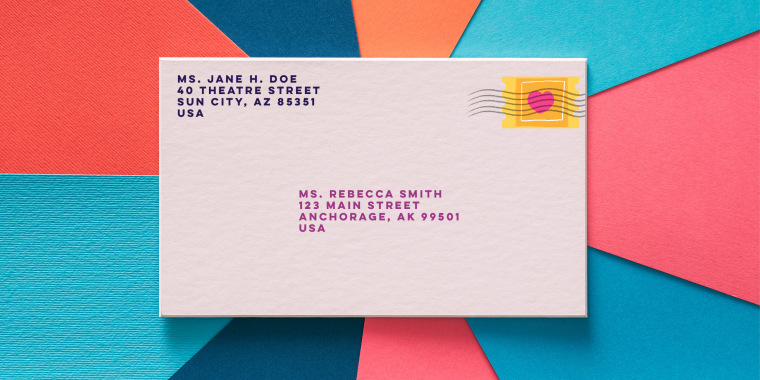In the age of technology where people can send quick texts to their friends or easily FaceTime their family, it seems crazy that anyone would still need to know how to address a letter. Believe it or not, however, sometimes handwritten letters are the ideal mode of communication.
What's on the inside is up to you, but it's important to follow specific guidelines for the outside of the envelope to ensure your letter is sent to whomever it's intended for.
How to address an envelope
- Write the return address in the top left corner.
- Then, write the recipient's address slightly centered on the bottom half of the envelope.
- To finish, place the stamp in the top right corner.
There are two addresses that are typically seen on the envelope, but only one is technically required: the recipient's. The sender's address isn't necessary, but it is recommended. If there are any mistakes that prevent the delivery of the letter, the lack of a return address means the post office will be unable to send it back in order to fix any problems.
How to write the sender's (return) address
- Start with your full name.
- Write your street address on the next line. If you need, it's okay to use two lines.
- Follow that line with the city, state and ZIP code of your address.
How to write the recipient's address
- For informal letters, follow the same format as the sender's address.
- If sending a letter to someone at a specific business, the first line should be the company's name.
- In the next line, follow "ATTN:" or "c/o" with the individual's name. If the letter is not to someone at a specific business, the first line should simply be their name.
- The next lines two should be the street address, city, state and ZIP code.
How to format military addresses (APO, FPO, DPO)
Even though they follow the same format as regular addresses, military addresses don't use the usual city and state names that many are used to.
- The city name will be either APO (Air/Army Post Office), FPO (Fleet Post Office) or DPO (Diplomatic Post Office).
- For the state, AA (Armed Forces America), AE (Armed Forces Europe) and AP (Armed Forces Pacific) are used, depending on the duty station.
- The ZIP code is the same, but sometimes the extra four number code is required for delivery.
How to write an international shipping address
If sending a letter to an overseas address that isn't military, the address format typically stays the same — just with the addition of the country name as the last line.
Some countries place the ZIP code in front of the city and country but it varies from country to country, so just check to be sure.
How to find the "ZIP+4" code
If you're unsure of the extra four-number code, USPS has a ZIP code lookup tool on their website.
- Choose to look up the ZIP code by address and enter all the required information.
- Press "Find" and USPS will give you the ZIP+4 code.
How many stamps should you use
Placing the stamp is easy, but knowing which stamps and how many to use is the hard part.
For a standard 1-ounce letter being shipped anywhere in America, Forever stamps are recommended because you'll always be able to use them regardless of future stamp price changes.
Every ounce over one costs 15 cents, so you'll have to use Additional Ounce stamps for every extra ounce. Two-ounce stamps are also an option.
If you're sending a postcard, don't cheat yourself with the Forever stamps. Postcards have their own stamps that are normally cheaper.
For international addresses, Global Forever stamps are used and just like the Forever stamps, you can use them whenever, regardless of price adjustments.
Irregular-shaped envelopes that may be used for square wedding invitations or graduation announcements require different stamps called non-machinable stamps. Because the square envelope can't fit the machine for automatic processing, the stamp costs a little extra to account for the non-machinable surcharge.
With the appropriate stamp, accurate addresses for both the sender and the recipient, and the right placement of all three on the envelope, your letter is ready to be sent!
from Fruitty Blog https://ift.tt/2AirfCd
via IFTTT

No comments:
Post a Comment